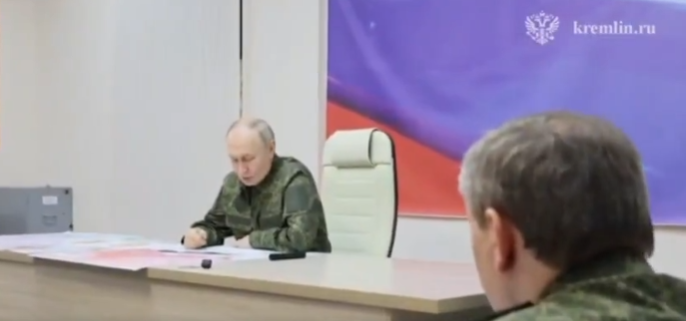Russia Rejects U.S.-Proposed Ceasefire with Ukraine as Putin Dons Military Fatigues on State TV
Russia Rejects U.S.-Proposed Ceasefire with Ukraine as Putin Dons Military Fatigues on State TV
March 13, 2025 – In a dramatic escalation of tensions, Russia has formally rejected a ceasefire proposal put forward by the United States aimed at halting the ongoing conflict with Ukraine. The announcement, delivered through Kremlin channels on Thursday, came shortly before President Vladimir Putin made a rare appearance on Russian state television clad in military fatigues—a symbolic gesture that analysts interpret as a signal of unwavering resolve amid mounting international pressure.
The U.S. ceasefire initiative, reportedly brokered through diplomatic backchannels in recent weeks, sought to freeze the frontlines in eastern Ukraine and establish a framework for de-escalation. While details of the proposal remain sparse, it was understood to include provisions for a temporary halt to hostilities, the withdrawal of heavy weaponry, and a commitment to renewed talks mediated by neutral parties. Ukrainian officials had expressed cautious optimism about the plan, though they emphasized that any agreement must guarantee their territorial sovereignty.
Russia’s rejection was swift and unequivocal. Foreign Ministry spokesperson Maria Zakharova described the proposal as “a superficial attempt by Washington to impose its will without addressing Russia’s core security concerns.” She accused the U.S. of ignoring Moscow’s long-standing demands, including Ukraine’s exclusion from NATO and the recognition of Russian territorial gains since the conflict began in 2022. “The West continues to fuel this war while pretending to seek peace,” Zakharova said in a statement broadcast across state media.
Hours later, President Putin appeared on Rossiya 1, Russia’s flagship state television channel, in a carefully staged segment that underscored the Kremlin’s defiant stance. Dressed in military fatigues—a departure from his usual tailored suits—Putin addressed the nation from an undisclosed location, flanked by uniformed soldiers. His attire and setting evoked memories of his early presidency, when he cultivated an image as a hands-on leader during the Second Chechen War.
“We will not be dictated to by those who arm our enemies and threaten our homeland,” Putin declared, his tone measured but firm. “Russia’s strength lies in its unity and determination. We will defend our people and our future by any means necessary.” The broadcast included footage of military drills, with tanks rolling across snowy plains and jets streaking overhead, reinforcing the message of readiness.
Analysts see Putin’s appearance as a deliberate move to rally domestic support and project power at a critical juncture. “The military fatigues are a visual cue—he’s positioning himself as a wartime leader,” said Dr. Elena Petrova, a Moscow-based political scientist. “Rejecting the ceasefire while dressing the part sends a clear signal: Russia is digging in, not backing down.”
The rejection of the ceasefire comes amid a stalled Russian offensive in Ukraine’s Donbas region, where brutal winter conditions and fierce Ukrainian resistance have slowed Moscow’s advances. Western intelligence reports suggest that both sides have suffered heavy casualties, with neither able to secure a decisive breakthrough. The U.S. proposal was seen as an attempt to prevent further bloodshed and avert a broader humanitarian crisis as spring approaches, potentially opening the door to renewed fighting on a larger scale.
In Kyiv, Ukrainian President Volodymyr Zelensky condemned Russia’s decision, calling it “proof of Moscow’s addiction to war.” Speaking at a press conference, Zelensky urged NATO and European allies to expedite military aid, including long-range missiles and air defense systems. “Every day of delay costs Ukrainian lives,” he said. “If Russia rejects peace, we will fight until they have no choice but to accept it.”
The White House expressed disappointment but not surprise at Russia’s response. “We remain committed to supporting Ukraine and pursuing every avenue to end this conflict,” a State Department spokesperson said. Behind closed doors, however, U.S. officials are reportedly weighing additional sanctions and increased weapons shipments to Kyiv, moves that could further strain relations with Moscow.
Putin’s television appearance has also sparked speculation about his next steps. Some observers suggest it could foreshadow a new mobilization effort to replenish Russia’s depleted forces, while others believe it’s a bluff to pressure the West into offering more favorable terms. Whatever the intent, the image of Putin in military garb is likely to dominate headlines, both in Russia and abroad, as the war grinds on with no end in sight.
As the international community scrambles to respond, one thing is clear: the rejection of the ceasefire and Putin’s martial posturing have dashed hopes for a quick resolution, plunging the region—and the world—into an uncertain and perilous future.
